Physical Address
304 North Cardinal St.
Dorchester Center, MA 02124
Among the most common malformations of the penis are those in which the distal urethral orifice is abnormally located, either on the ventral (hypospadias) or dorsal (epispadias) aspect of the penis. The anomalous orifice may be constricted, resulting in urinary tract obstruction and an increased risk for urinary tract infections. Hypospadias occurs in 1 in 300 live male births and may be associated with other congenital anomalies, such as inguinal hernia and undescended testis.
The contributions to this chapter by Dr. Jonathan I. Epstein and Dr. Tamara L. Lotan, Department of Pathology, Johns Hopkins University School of Medicine, Baltimore, Maryland, in several previous editions of this book are gratefully acknowledged. The editors also appreciate the contributions to the current chapter by Dr. George Jabboure Netto, Department of Pathology, University of Alabama at Birmingham.
Balanitis and balanoposthitis refer to local inflammation of the glans penis and of the overlying prepuce, respectively, due to infection. Among the more common agents are Candida albicans; anaerobic bacteria, including Gardnerella; and pyogenic bacteria. Most cases occur because of poor hygiene in uncircumcised males, which leads to the accumulation of desquamated epithelial cells, sweat, and debris, termed smegma, that acts as a local irritant and nidus for infection. Phimosis is a condition in which the prepuce cannot be retracted easily over the glans penis, usually due to scarring secondary to balanoposthitis, though it may also be a congenital anomaly.
The vast majority (more than 95%) of penile malignancies are squamous cell carcinomas. These are very rare in the United States, Europe, and other higher-resource countries; however, in lower-resource countries, penile carcinoma accounts for 10% to 20% of cancers in men. Most cases occur in uncircumcised patients older than 40 years of age. Low-income status, poor hygiene habits, smoking, chronic inflammation, and human papillomavirus (HPV) infection are risk factors.
Squamous cell carcinoma precursor of the penis (penile intraepithelial neoplasm [PeIN]) most commonly affects the penile shaft and scrotum of older men and appears grossly as a solitary plaque. Histologic examination reveals dysplastic cells throughout the epidermis without invasion of the underlying stroma ( Fig. 16.1 ). Ten percent of patients subsequently develop invasive squamous cell carcinoma.
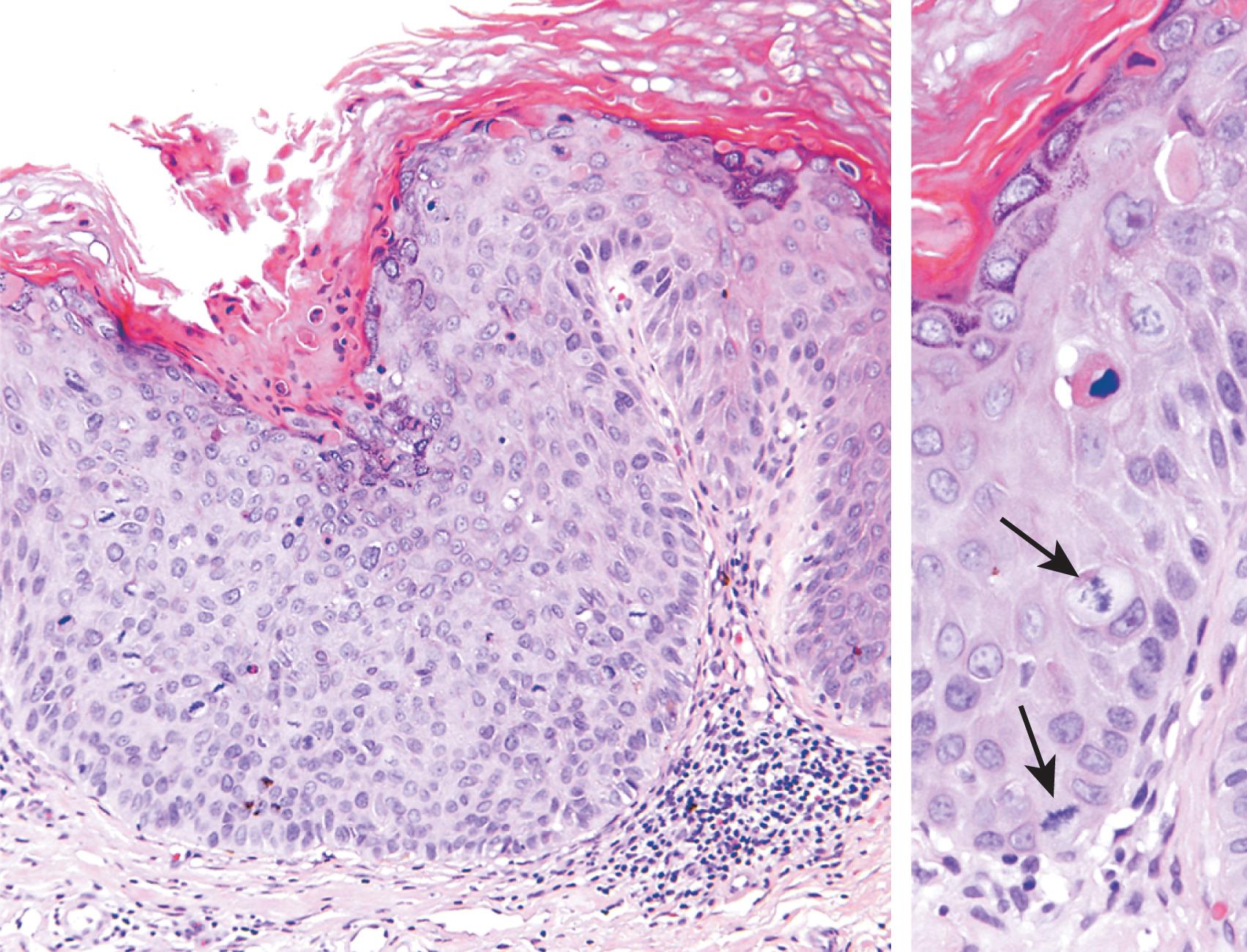
Invasive squamous cell carcinoma of the penis typically appears as a gray, crusted, papular lesion on the glans penis or prepuce. Infiltration of the underlying connective tissue produces an indurated, ulcerated lesion with irregular margins ( Fig. 16.2 ). It is associated with HPV-16 and HPV-18 (high-risk types) infections. Histologically, the tumor is most often a typical keratinizing squamous cell carcinoma. The prognosis is related to the stage of the tumor. Patients with metastasis to multiple (3 or greater) or bilateral inguinal lymph nodes or to pelvic lymph nodes have a poor prognosis. Verrucous carcinoma, a non-HPV–related variant of squamous cell carcinoma, is characterized by papillary architecture, virtually no cytologic atypia, and rounded, pushing deep margins; such tumors are locally invasive but do not metastasize.
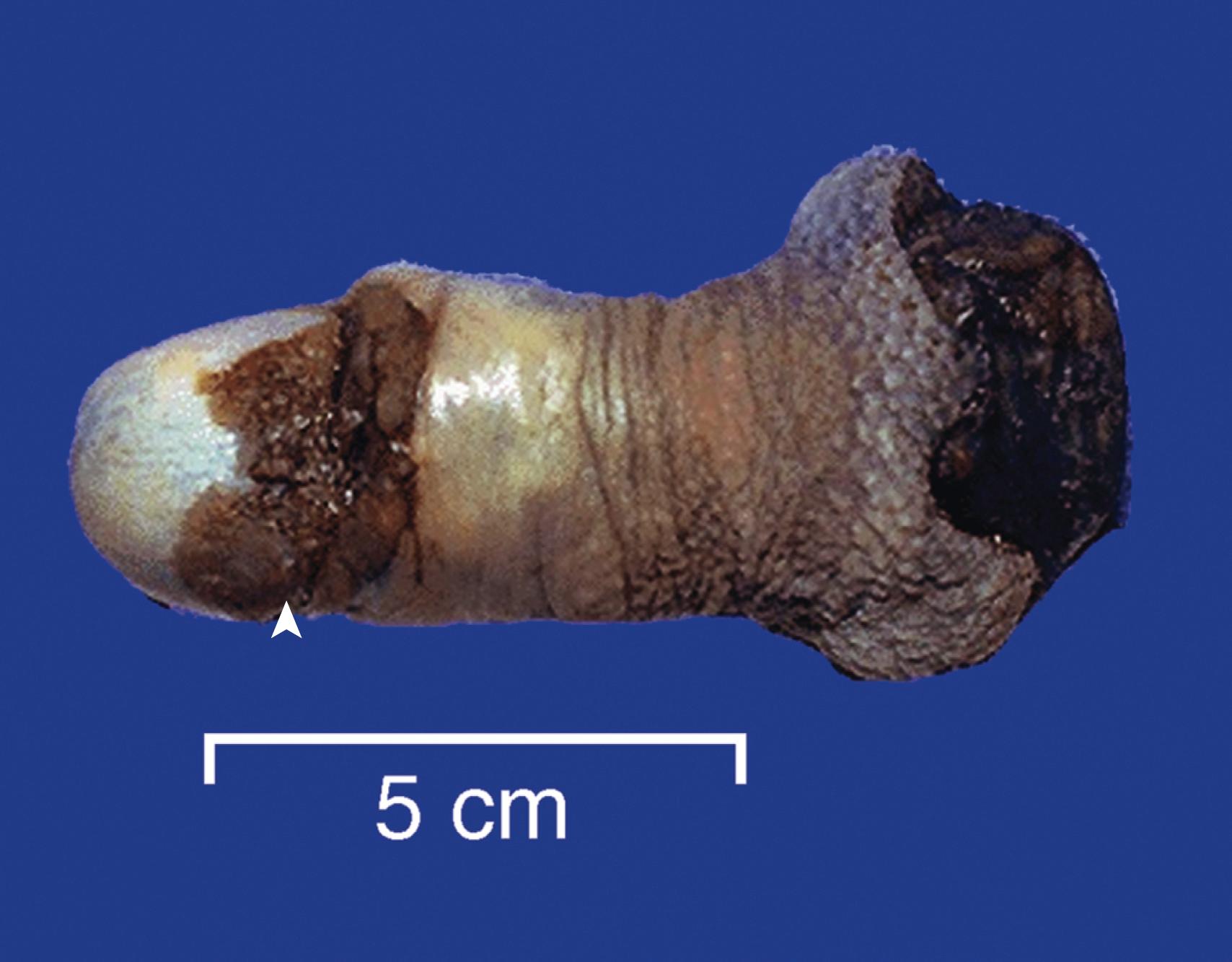
Several inflammatory processes may affect the skin of the scrotum, including local fungal infections and systemic dermatoses, such as psoriasis ( Chapter 22 ). Neoplasms of the scrotal sac are unusual; squamous cell carcinoma is the most common of these. Scrotal enlargement may be due to accumulation of fluid in the tunica vaginalis: hydrocele (serous fluid), which may be idiopathic or in response to adjacent infections or tumors; hematocele (blood) secondary to trauma or torsion; and chylocele (lymphatic fluid), which may be secondary to filariasis. The clear fluid of a hydrocele allows light to pass through (transluminescence), allowing distinction from other fluids and tumors of the testis.
Cryptorchidism is a complete or partial failure of the intraabdominal testes to descend into the scrotal sac. It is associated with testicular dysfunction and an increased risk of testicular cancer. Cryptorchidism is found in approximately 1% of 1-year-old boys. Normally, the testes descend from the abdominal cavity into the pelvis by the third month of gestation and then through the inguinal canals into the scrotum during the last 2 months of intrauterine life. The diagnosis of cryptorchidism is only established with certainty after 1 year of age, particularly in premature infants, because testicular descent into the scrotum is not always complete at birth. The condition is bilateral in approximately 25% of affected patients. Because undescended testes become atrophic, bilateral cryptorchidism results in sterility. Even unilateral cryptorchidism may be associated with atrophy of the contralateral descended gonad.
In addition to infertility, failure of testicular descent is associated with an increased risk for testicular cancer. Patients with unilateral cryptorchidism are also at increased risk for the development of cancer in the contralateral, normally descended testis, suggesting that an intrinsic abnormality, rather than simple failure of descent, underlies both the increased cancer risk and the aforementioned increased risk of testicular atrophy and sterility. Cryptorchid testes are small and firm. The histologic changes in the malpositioned testis begin as early as 2 years of age and include thickening of the basement membrane, loss of spermatogonia, increased interstitial stroma, and relative prominence of Leydig cells. Germ cell neoplasia in situ (discussed later) may be present in cryptorchid testes and is a likely precursor of subsequent germ cell tumors. Current recommendations are for surgical repositioning (orchiopexy), to be performed at 6 to 12 months of age.
Inflammatory lesions of the testis are more common in the epididymis than in the testis proper. Sexually transmitted infectious disorders are discussed later in the chapter. Other causes of testicular inflammation include nonspecific epididymitis and orchitis, mumps, and tuberculosis.
Nonspecific epididymitis and orchitis usually begin as a primary urinary tract infection that spreads to the testis through the vas deferens or the lymphatics of the spermatic cord. The involved testis is swollen and tender, and histologic examination reveals numerous neutrophils.
Mumps infection involving the testes is rare in children but occurs in 20% to 30% of postpubertal males; typically, acute interstitial orchitis develops 1 week after the onset of swelling of the parotid glands. Sterility is a rare complication.
Testicular tuberculosis is the most common cause of testicular granulomatous inflammation. It generally begins as an epididymitis, with secondary involvement of the testis. Histologic findings are identical to those seen in active tuberculosis elsewhere. Other causes of granulamatous inflammation include autoimmune orchitis, which sometimes develops after injury and release of normally sequestered testicular antigens.
Torsion, or twisting of the spermatic cord, typically results in obstruction of testicular venous drainage while the thick-walled and more resilient arteries remain patent. If untreated, this results in intense vascular engorgement and infarction ( eFig. 16.1 ). There are two types of testicular torsion: neonatal torsion, which occurs either in utero or shortly after birth and has no associated anatomic defect, and “adult” torsion . The latter results from a bilateral anatomic defect in anchoring of the testis in the scrotal sac that leads to their increased mobility. Adult torsion typically occurs in adolescence and manifests with the sudden onset of testicular pain.
Torsion constitutes one of the few urologic emergencies. If the testis can be manually untwisted within 6 hours of onset, it remains viable. Contralateral orchiopexy is performed to prevent recurrence in the unaffected testis.
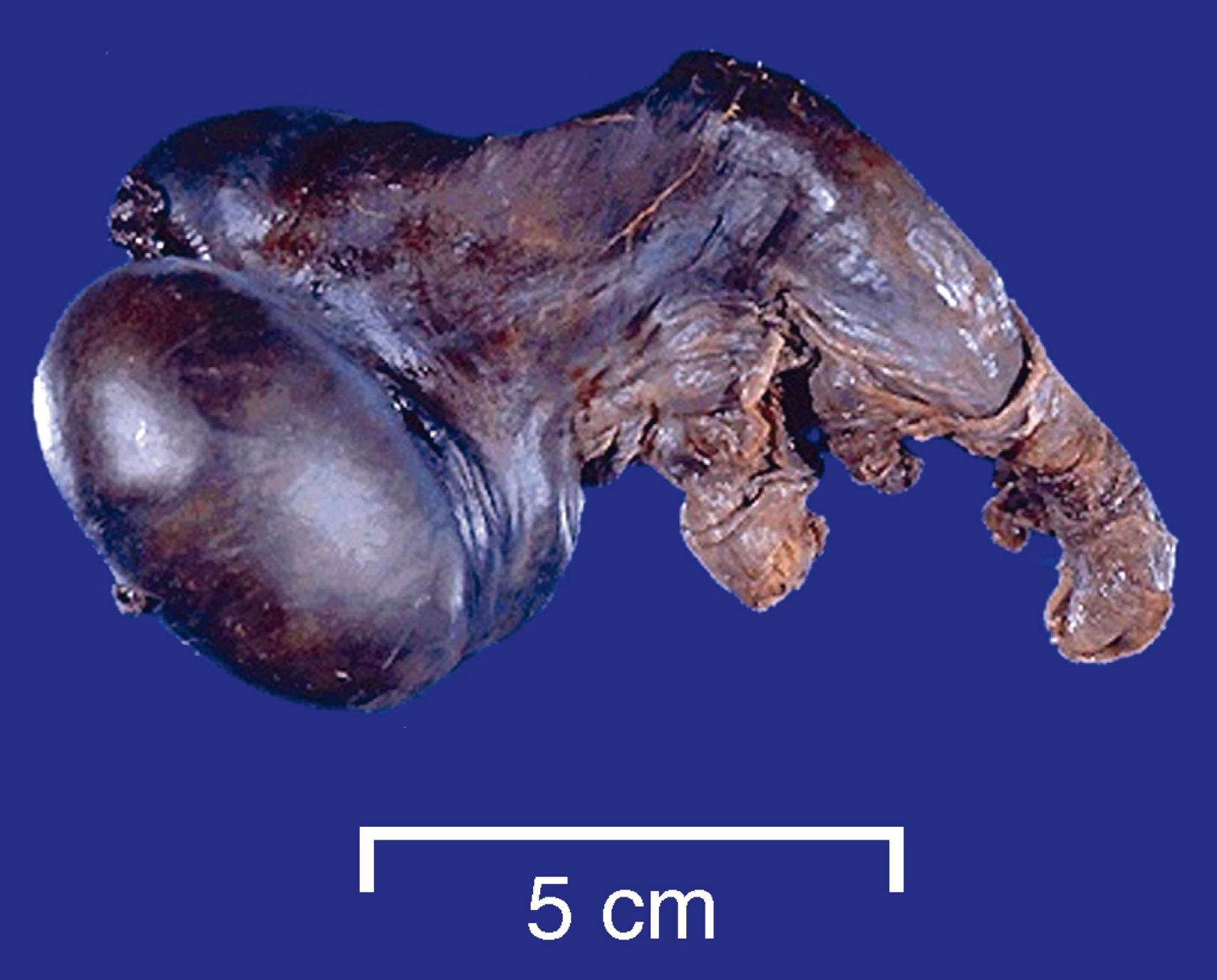
Ninety-five percent of testicular tumors arise from germ cells, and almost all are malignant. By contrast, sex cord-stromal tumors derived from Sertoli or Leydig cells are uncommon and usually benign. The focus of the remainder of this discussion is on testicular germ cell tumors.
The cause of testicular neoplasms is poorly understood; both genetic and environmental factors contribute to their development. Incidence is lowest in Africa and Asia but has increased worldwide over recent decades. Family history is important, as fathers and sons of affected patients have a 4-fold increased risk and brothers of males with germ cell tumors have an 8- to 10-fold increased risk. As discussed earlier, cryptorchidism is associated with an increased risk for cancer in the undescended testis, as well as in the contralateral descended testis. In keeping with this, a history of cryptorchidism is present in approximately 10% of cases of testicular cancer. Intersex syndromes, including androgen insensitivity syndrome and gonadal dysgenesis, are also associated with an increased frequency of testicular cancer. The development of cancer in one testis is associated with a markedly increased risk for neoplasia in the contralateral testis. Extra copies of the short arm of chromosome 12, usually due to the presence of an isochromosome 12 [i(12p)], are found in virtually all germ cell tumors; it is not known which genes in this chromosomal segment are linked to tumorigenesis. Oncogenic mutations in KIT are found in up to 25% of tumors.
Most testicular tumors in postpubertal males arise from a precursor lesion called germ cell neoplasia in situ. This lesion is present in conditions associated with a high risk for developing germ cell tumors (e.g., cryptorchidism) and exhibits the same abnormality of chromosome 12 when associated with fully developed germ cell tumors. Germ cell neoplasia in situ is often found in testicular tissue adjacent to germ cell tumors. Recall that in many other organs (e.g., pancreas, colon, prostate), precursor lesions are also found adjacent to cancers.
Testicular germ cell tumors are subclassified into seminoma and nonseminomatous tumors ( Table 16.1 ). Seminoma is most common, accounting for about 50% of testicular germ cell neoplasms. They are histologically identical to tumors called dysgerminomas, which occur in the ovary, and germinomas, which occur in the central nervous system and other extragonadal sites.
Germ cell tumors may be composed of a single (∼60% of cases) or multiple histologic types. Seminoma presents as a soft, well-demarcated, gray-white tumor that bulges from the cut surface of the affected testis ( Fig. 16.3 ). Large tumors may contain foci of coagulative necrosis, usually without hemorrhage. It is composed of large uniform cells with distinct cell borders, clear glycogen-rich cytoplasm, round nuclei, and conspicuous nucleoli ( Fig. 16.4 ). The cells often are arrayed in small lobules with intervening fibrous septa. A lymphocytic infiltrate is usually present. Seminoma may also elicit a granulomatous reaction. In approximately 15% of cases, syncytiotrophoblasts are present; these cells are the source of the minimally elevated serum human choriogonadotropin (hCG) that is seen in 10% to 15% of patients with stage I disease, increasing to 30% to 50% in disseminated disease. Their presence has no bearing on prognosis, and the levels of hCG are usually much lower than in choriocarcinoma, described later.
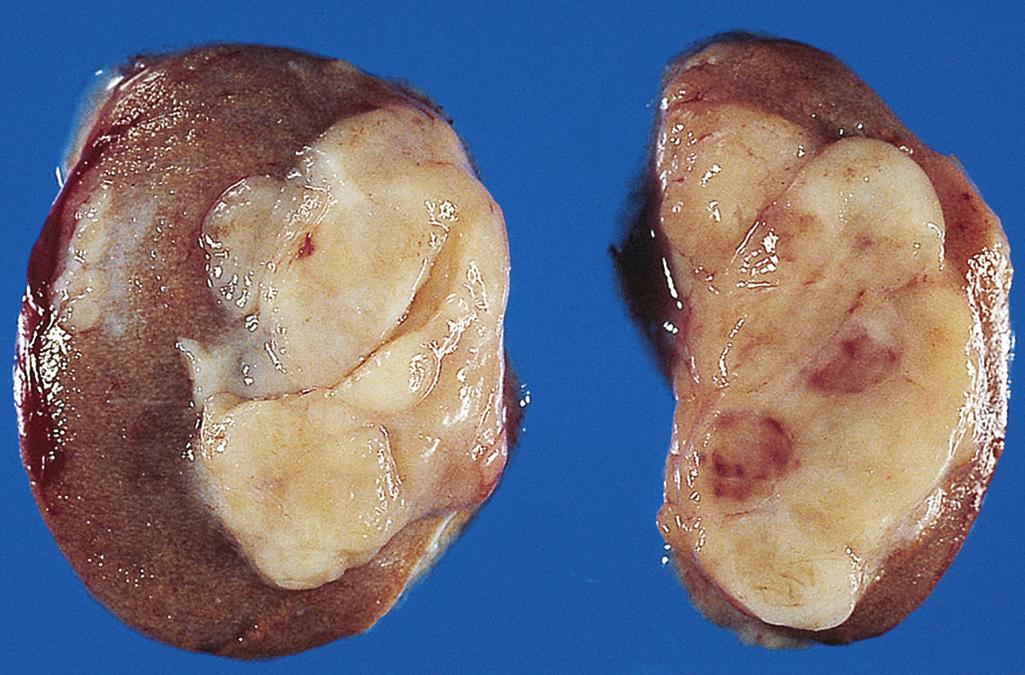
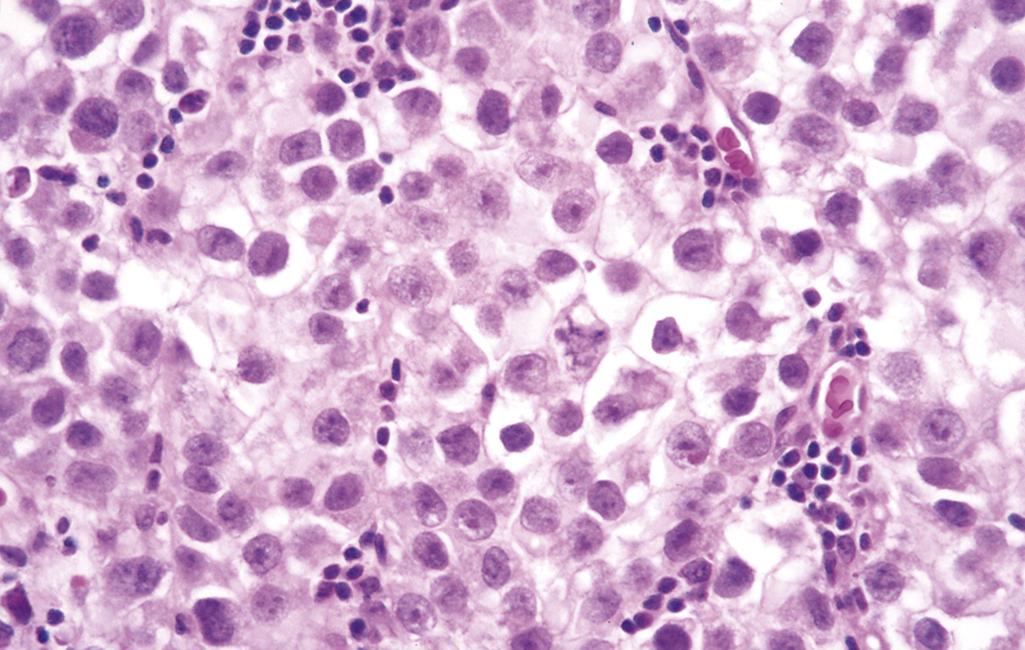
Spermatocytic tumor (previously called spermatocytic seminoma) is uncommon, representing 1% to 2% of all testicular germ cell neoplasms. In contrast to other germ cell tumors, affected individuals are generally older (usually more than 65 years old). This slow-growing tumor does not metastasize and when treated by surgical resection has an excellent prognosis. The polygonal cells bear some morphologic resemblance to seminoma, but the origin and pathogenesis of spermatocytic tumor are quite distinct: it is not associated with germ cell neoplasia in situ, lacks isochromosome 12p, and is characteristically associated with gain of chromosome 9q.
Embryonal carcinoma presents as ill-defined, invasive masses containing foci of hemorrhage and necrosis ( Fig. 16.5 ). The primary lesions may be small, even in patients with systemic metastases. The tumor cells are large and have basophilic cytoplasm, indistinct cell borders, large nuclei, and prominent nucleoli. The neoplastic cells may be arranged in undifferentiated, solid sheets or may form primitive glandular structures and irregular papillae ( Fig. 16.6 ). In most cases, cells characteristic of other germ cell tumors (e.g., yolk sac tumor, teratoma, choriocarcinoma) are admixed with the embryonal areas. Pure embryonal carcinomas account for only 2% to 3% of all testicular germ cell tumors.
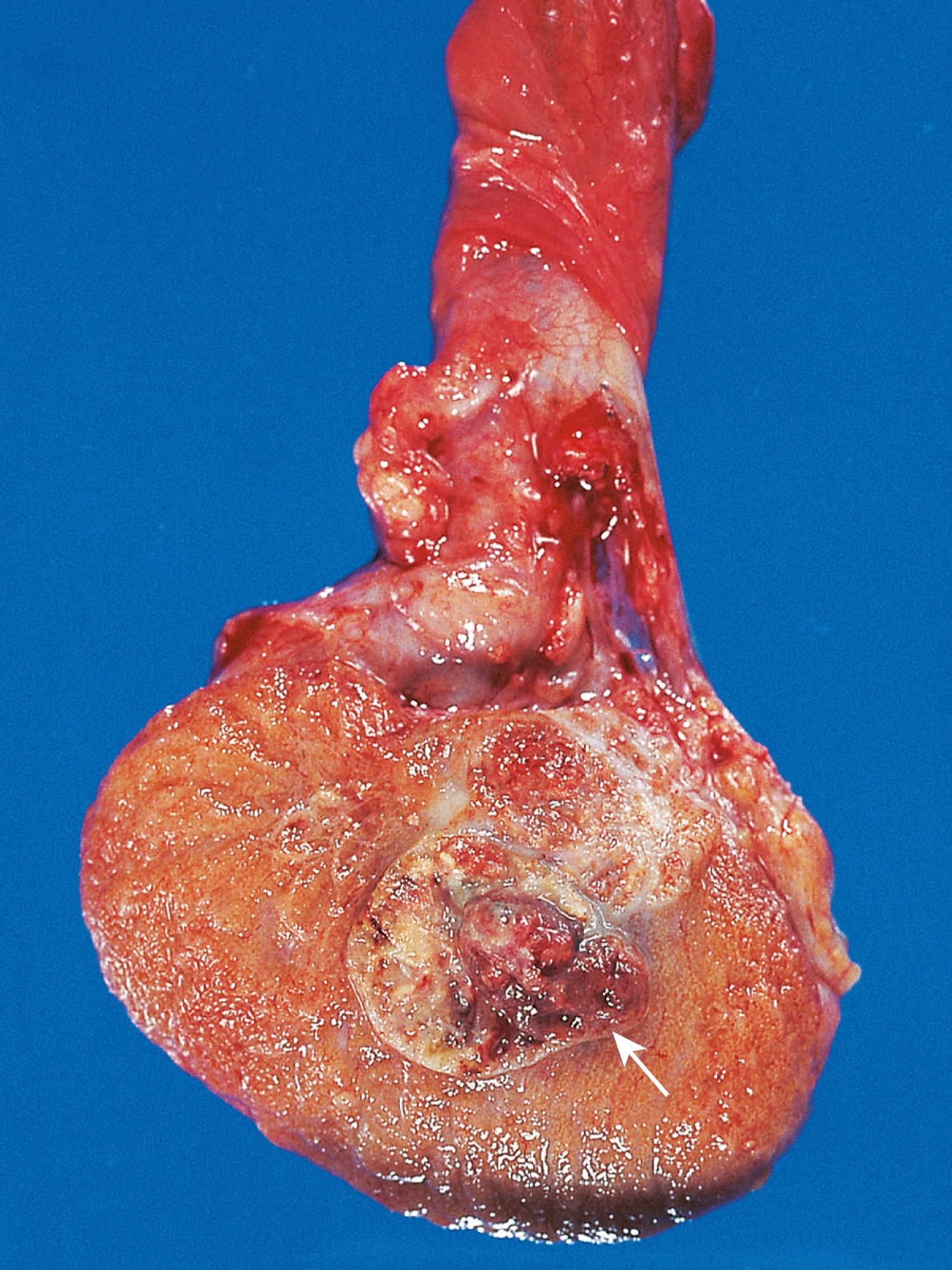
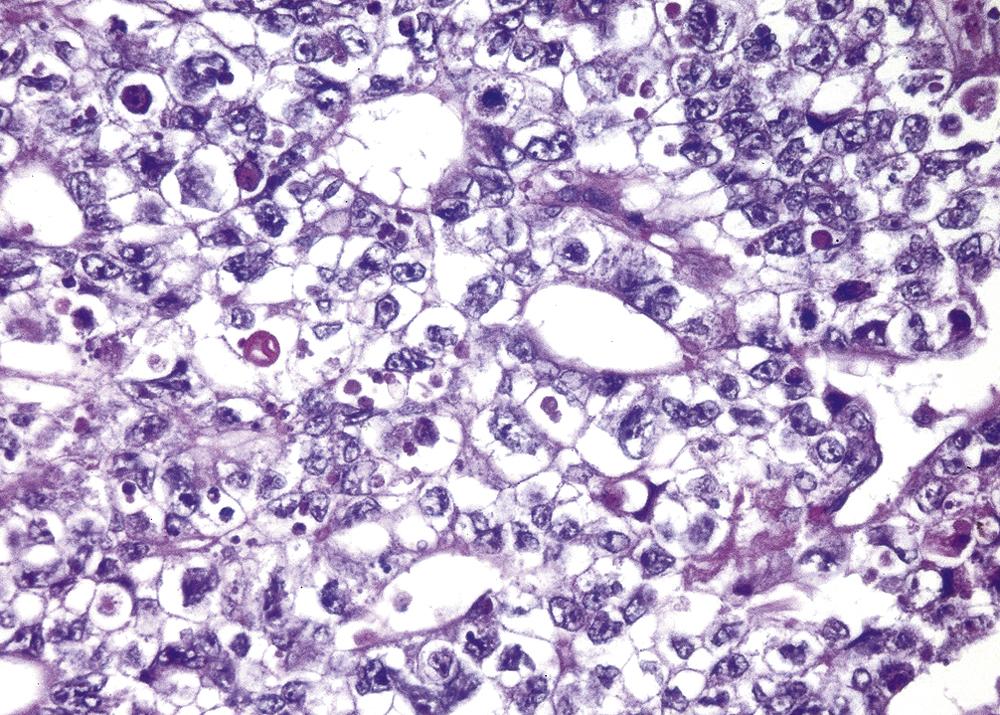
Yolk sac tumor is the most common primary testicular neoplasm in children younger than 3 years of age; in this age group, it has a very good prognosis. By contrast, postpubertal yolk sac tumor is rarely “pure” and more frequently occurs in combination with embryonal carcinoma or other germ cell components. Tumors are composed of low cuboidal to columnar epithelial cells that form microcysts, lacelike (reticular) patterns, sheets, glands, and papillae ( Fig. 16.7 ). A distinctive feature is the presence of structures resembling primitive glomeruli, so-called Schiller-Duval bodies. These tumors often have eosinophilic hyaline globules containing α 1 -antitrypsin and alphafetoprotein (AFP), which can be demonstrated by immunohistochemical techniques.
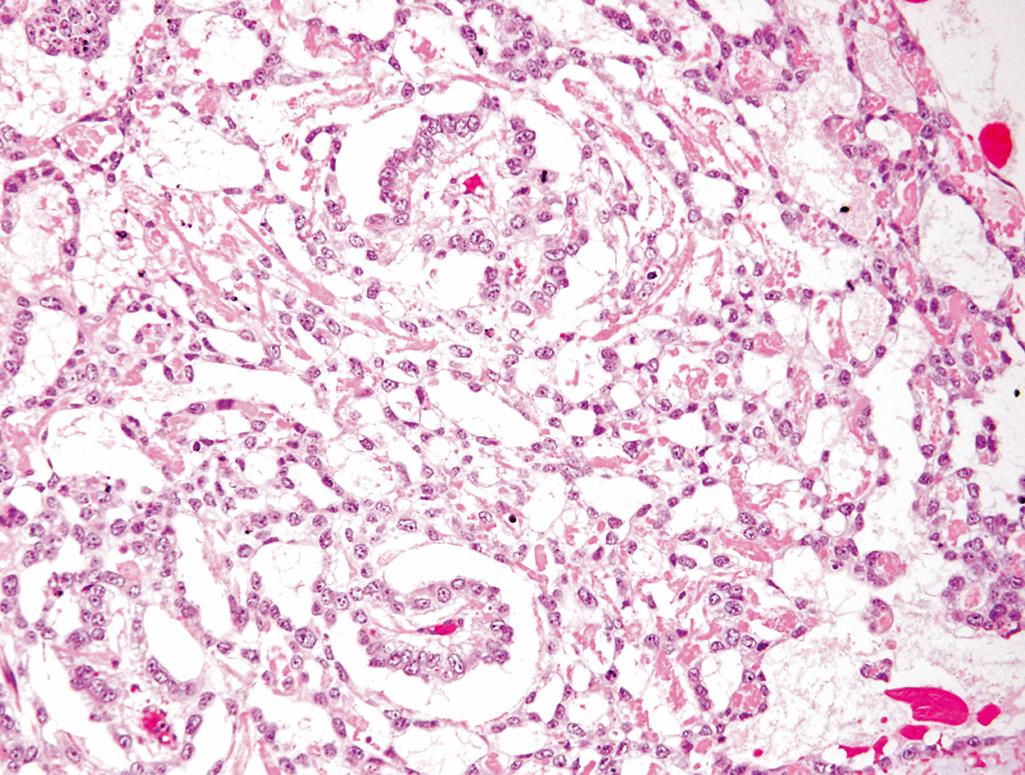
Choriocarcinoma is a highly malignant tumor in which the neoplastic germ cells differentiate into cells resembling placental trophoblasts. The primary tumors are often small and nonpalpable, even in patients with extensive metastatic disease. The tumor is composed of sheets of small cuboidal cytotrophoblast-like cells that are irregularly intermingled with or capped by large, eosinophilic syncytiotrophoblast-like cells containing multiple dark, pleomorphic nuclei ( Fig. 16.8 ). Hemorrhage and necrosis are extremely common. hCG can be identified in the syncytiotrophoblastic cells by immunohistochemical staining.
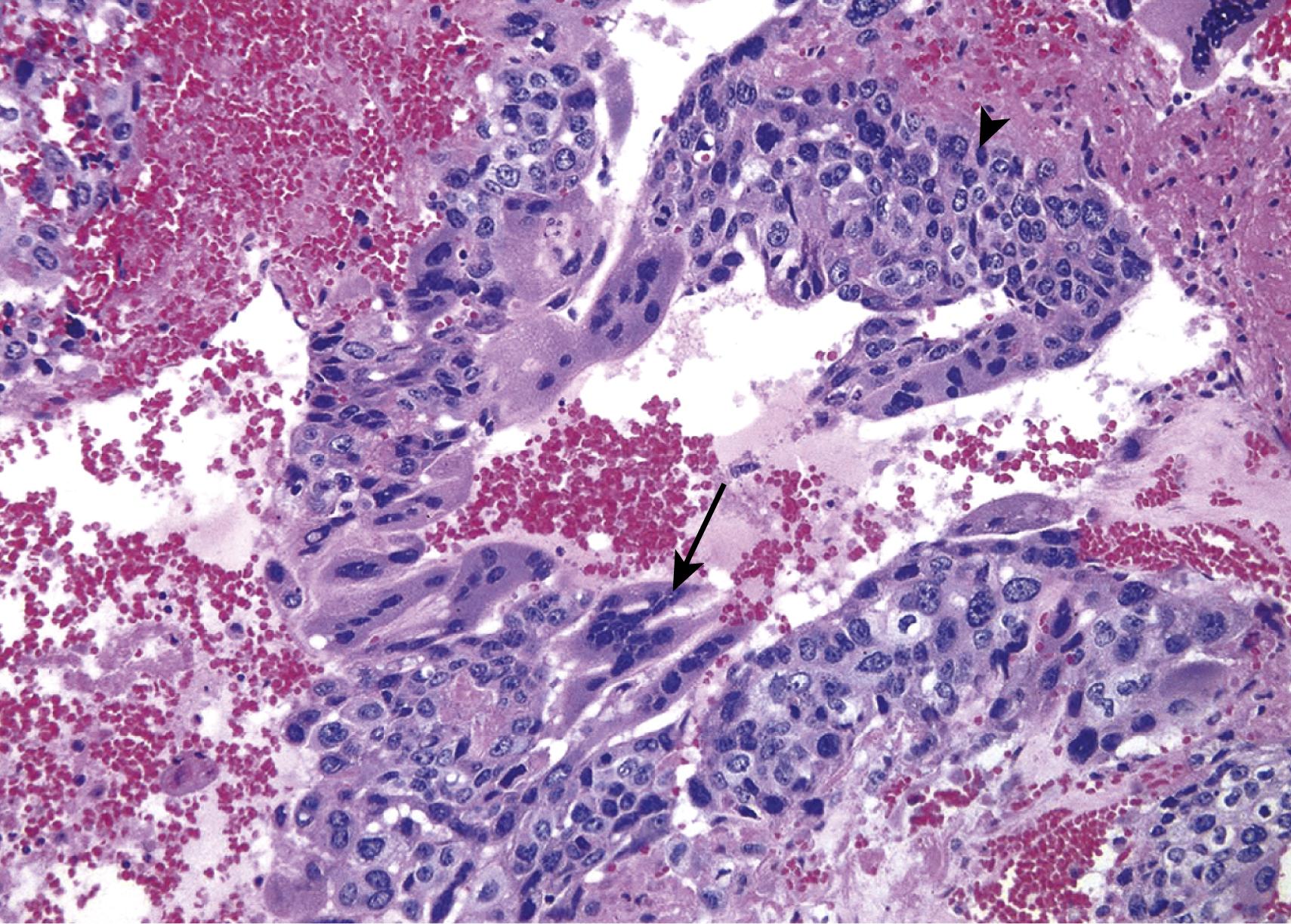
Teratoma is a tumor in which the neoplastic germ cells differentiate along multiple somatic cell lineages. They may occur at any age from infancy to adulthood. Pure teratoma is fairly common in infants and children and is referred to as the “prepubertal type.” Among germ cell tumors, teratomas are second in frequency in infants and children only to yolk sac tumors. In adults, pure teratomas are rare, constituting 2% to 3% of germ cell tumors; more often teratomas are found mixed with other tumor types such as embryonal carcinoma or yolk sac tumor. The presence of a variety of tissues imparts a heterogeneous appearance, with solid, sometimes cartilaginous, and cystic areas ( eFig. 16.2 ). Microscopically, there are collections of differentiated cells or organoid structures, such as neural tissue, muscle bundles, islands of cartilage, squamous epithelium lining epidermal-like surfaces with or without skin adnexal structures, structures reminiscent of thyroid gland, bronchial epithelium, and bits of intestinal wall or brain substance, embedded in a fibrous or myxoid stroma ( Fig. 16.9 ). Elements may be mature (resembling various tissues within the adult) or immature (sharing histologic features with fetal or embryonal tissues). Prepubertal teratomas are not associated with germ cell neoplasia in situ or isochromosome 12p and pursue a benign course. Only a minor fraction of teratomas occurring in adults share these features, and postpubertal adult teratomas are generally taken to be malignant, regardless of the presence of immature elements.
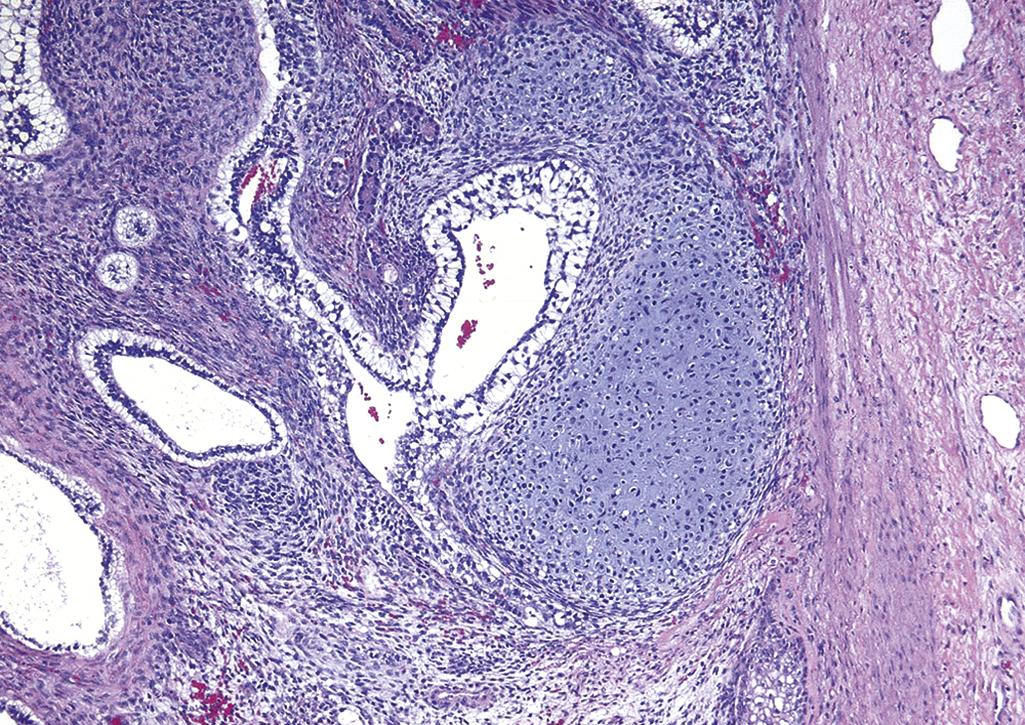
Rarely, nongerm cell cancers may arise in teratoma, a phenomenon referred to as teratoma with somatic-type malignancy. Examples of such neoplasms include squamous cell carcinoma, adenocarcinoma, and various sarcomas. These nongerm cell malignancies do not respond to therapies that are effective against metastatic germ cell tumors (discussed later); thus, the only hope for cure in such cases is surgical resection.
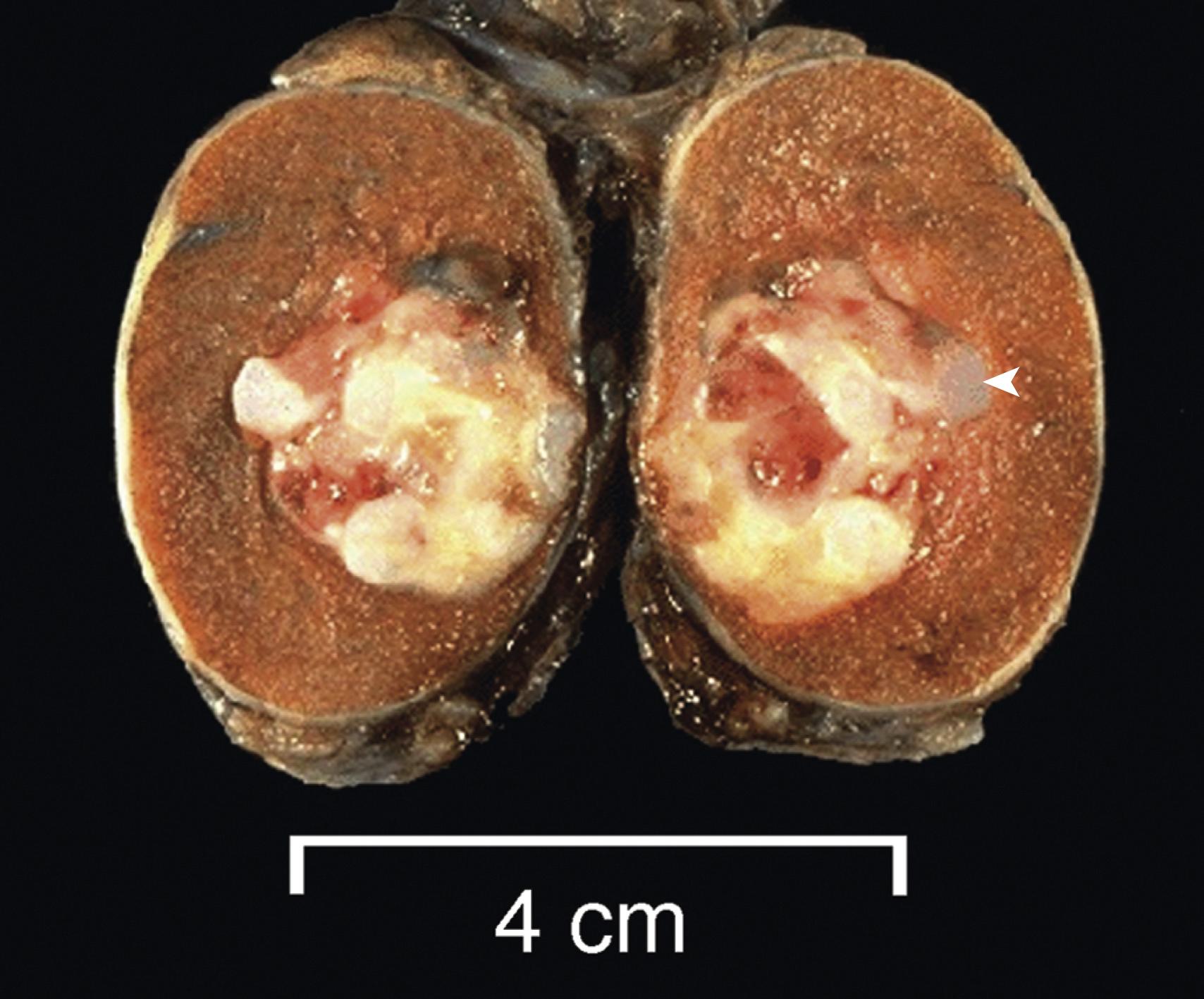
| Tumor | Peak Patient Age (years) | Morphology | Tumor Marker(s) |
|---|---|---|---|
| Seminoma | 40–50 | Sheets of uniform polygonal cells with clear cytoplasm; lymphocytes in the stroma | 10% of patients have elevated hCG |
| Embryonal carcinoma | 20–30 | Poorly differentiated, pleomorphic cells in cords, sheets, or papillary formation; most contain some yolk sac and choriocarcinoma cells | AFP may be elevated |
| Spermatocytic tumor | 50–60 | Small, medium, and large polygonal cells; no inflammatory infiltrate | Negative |
| Yolk sac tumor | 3 | Poorly differentiated flattened, cuboidal, or columnar cells | 90% of patients have elevated AFP |
| Choriocarcinoma | 20–30 | Cytotrophoblast and syncytiotrophoblast without villus formation | 100% of patients have elevated hCG |
| Teratoma | All ages | Tissues from all three germ cell layers with varying degrees of differentiation | 20%–25% have elevated AFP |
| Mixed tumor | 15–30 | Variable, depending on mixture; commonly teratoma and embryonal carcinoma | AFP and hCG are variably elevated, depending on mixture |
Patients with testicular germ cell neoplasms present most frequently with a painless testicular mass that (unlike enlargements caused by hydroceles) is nontranslucent. Biopsy of a testicular neoplasm is associated with a risk for tumor spillage, which would necessitate excision of the scrotal skin in addition to orchiectomy. Consequently, the standard management of a solid testicular mass is radical orchiectomy, based on the presumption of malignancy. Some tumors, especially nonseminomatous germ cell neoplasms, may metastasize by the time of diagnosis in the absence of a palpable testicular lesion.
Seminoma and nonseminomatous tumors differ in their behavior and clinical course.
Seminoma often remains confined to the testis for long periods and may reach considerable size before diagnosis. Metastases are most commonly encountered in the iliac and paraaortic lymph nodes. Hematogenous metastases occur late in the course of the disease.
Nonseminomatous germ cell neoplasms tend to metastasize earlier, by lymphatic as well as hematogenous routes. Hematogenous metastases are most common in the liver and lungs. The histology of metastases and distant recurrences may differ from that of the testicular lesion.
Assay of tumor markers secreted by germ cell tumors is important for two reasons: (1) these markers (summarized in Table 16.1 , along with salient clinical and morphologic features) are helpful diagnostically and (2) they are valuable in following the response of tumors to therapy after the diagnosis is established. hCG is always elevated in patients with choriocarcinoma and, as noted, may be minimally elevated in individuals with other germ cell tumors containing syncytiotrophoblastic cells. Increased AFP in the setting of a testicular neoplasm indicates a yolk sac tumor component and can also be seen in some embryonal carcinomas and teratomas. Serum levels of lactate dehydrogenase (LDH) correlate with the tumor burden.
The therapy and prognosis of testicular tumors depend largely on the clinical and pathologic stage and the histologic type. Seminoma, which is radiosensitive and chemosensitive, has the best prognosis. More than 95% of patients with stage I and II seminoma are cured by orchiectomy with or without chemotherapy or radiotherapy. In patients with nonseminomatous germ cell tumors, approximately 90% achieve complete remission with aggressive chemotherapy, and most can be cured. Pure embryonal carcinoma behaves more aggressively than mixed germ cell tumors. Pure choriocarcinoma and mixed germ cell tumors with predominantly choriocarcinoma have a poor prognosis.
The prostate can be divided into biologically distinct regions, the most important of which are the peripheral and transition zones ( Fig. 16.10 ). The types of proliferative lesions are different in each region. For example, most hyperplastic lesions arise in the inner transition zone, while most carcinomas (70%–80%) arise in the peripheral zones. As a result, carcinomas can be detected by rectal examination, whereas hyperplasias are more likely to come to attention due to symptoms of urinary obstruction. The normal prostate contains glands with two cell layers, a flat basal cell layer and an overlying columnar secretory cell layer. Surrounding prostatic stroma contains a mixture of smooth muscle and fibrous tissue. The prostate is involved by infectious, inflammatory, hyperplastic, and neoplastic disorders, of which prostate cancer is by far the most important clinically.
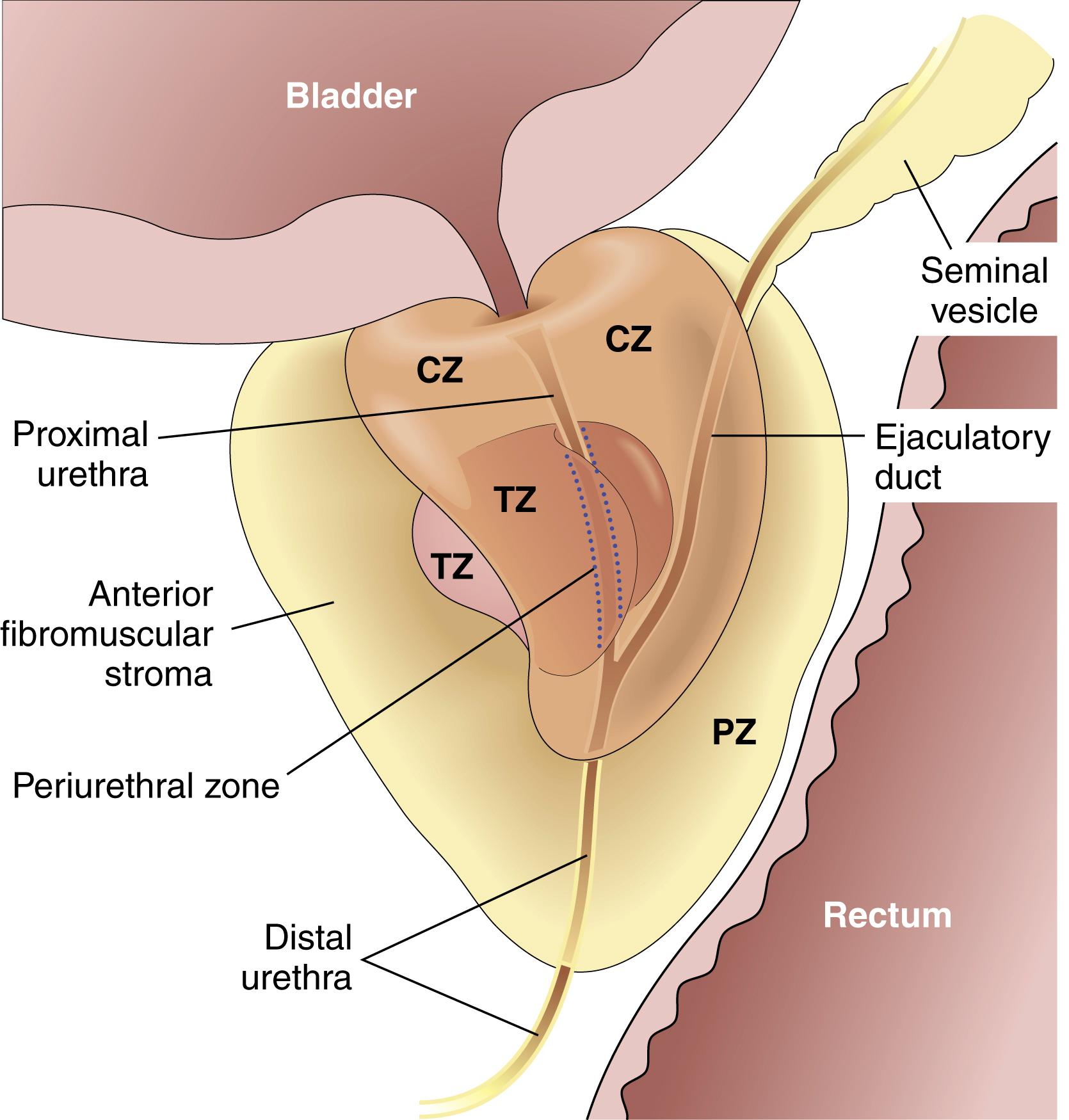
There are three main types of prostatitis: (1) acute bacterial prostatitis, caused by the same organisms that cause other acute urinary tract infections; (2) chronic bacterial prostatitis, also caused by common uropathogens; and (3) chronic abacterial prostatitis, often referred to clinically as pelvic pain syndrome . The latter is the most common form of prostatitis.
The diagnosis of prostatitis is not typically based on biopsy, since the histologic findings are nonspecific and biopsy of an infected prostate can result in sepsis. The exception is granulomatous prostatitis, which may produce prostatic induration, leading to biopsy to rule out prostate cancer. In the United States, the most common cause of granulomatous prostatitis is instillation of bacille Calmette-Guérin (BCG) within the bladder for treatment of superficial bladder cancer (see later). Fungal granulomatous prostatitis is typically seen only in patients who are immunocompromised. Nonspecific granulomatous prostatitis is relatively common and stems from a foreign-body reaction to fluids that leak into tissue from ruptured prostatic ducts and acini.
Acute bacterial prostatitis presents with sudden onset of fever, chills, dysuria, perineal pain, and bladder outlet obstruction; it may be complicated by sepsis. If acute prostatitis is suspected, digital rectal examination is contraindicated, as pressure on the exquisitely tender prostate can cause bacteremia; diagnosis can be established by urine culture and clinical features. Chronic bacterial prostatitis is usually associated with recurrent urinary tract infections interspersed with asymptomatic periods. Presenting manifestations include low back pain, dysuria, and perineal and suprapubic discomfort. Diagnosis depends on the demonstration of leukocytosis in expressed prostatic secretions and positive bacterial cultures. Both acute and chronic bacterial prostatitis are treated with antibiotics. Chronic abacterial prostatitis is indistinguishable from chronic bacterial prostatitis in terms of signs and symptoms, but lacks a history of recurrent urinary tract infection. Expressed prostatic secretions contain more than 10 leukocytes per high-power field (indicating presence of inflammation), but bacterial cultures are uniformly negative. The etiology is uncertain, and it is a diagnosis of exclusion. Therapy for chronic pelvic pain syndrome is empirical and depends on the nature of the symptoms.
Benign prostatic hyperplasia (BPH) results from stromal and glandular proliferation and is the most common benign prostatic disease in men older than 50 years. Its frequency rises progressively with age, reaching 90% by the eighth decade of life. Enlargement of the prostate in men with BPH is an important cause of urinary obstruction.
Although the cause of BPH is incompletely understood, excessive androgen-dependent growth of stromal and glandular elements has a central role. BPH does not occur in males who are castrated before the onset of puberty or in males with genetic diseases that block androgen activity. Dihydrotestosterone (DHT), the androgen that is the ultimate mediator of prostatic growth, is 10 times more potent than testosterone and is synthesized in the prostate from circulating testosterone by the action of the enzyme 5α-reductase, type 2. DHT binds to nuclear androgen receptors (which also bind testosterone) and thereby regulates the expression of genes that support the growth and survival of prostatic epithelium and stromal cells. It is believed that DHT-induced growth factors act by increasing the proliferation of stromal cells and decreasing the death of epithelial cells. With aging, testosterone levels decline while estrogen levels remain unchanged and may increase due to peripheral conversion of androgens; estrogens may act synergistically with DHT to drive growth of epithelial and stromal cells, both of which express estrogen receptors.
In BPH the weight of the enlarged prostate often increases 3- to 5-fold (60 to 100 g) or greater. BPH affects the transition zone and thus often encroaches on the urethra, compressing it to a slitlike orifice. On cross-section, hyperplastic nodules are seen that vary in color and consistency depending on their cellular content ( Fig. 16.11A ). The nodules may appear solid or contain cystic spaces, the latter corresponding to dilated glands.
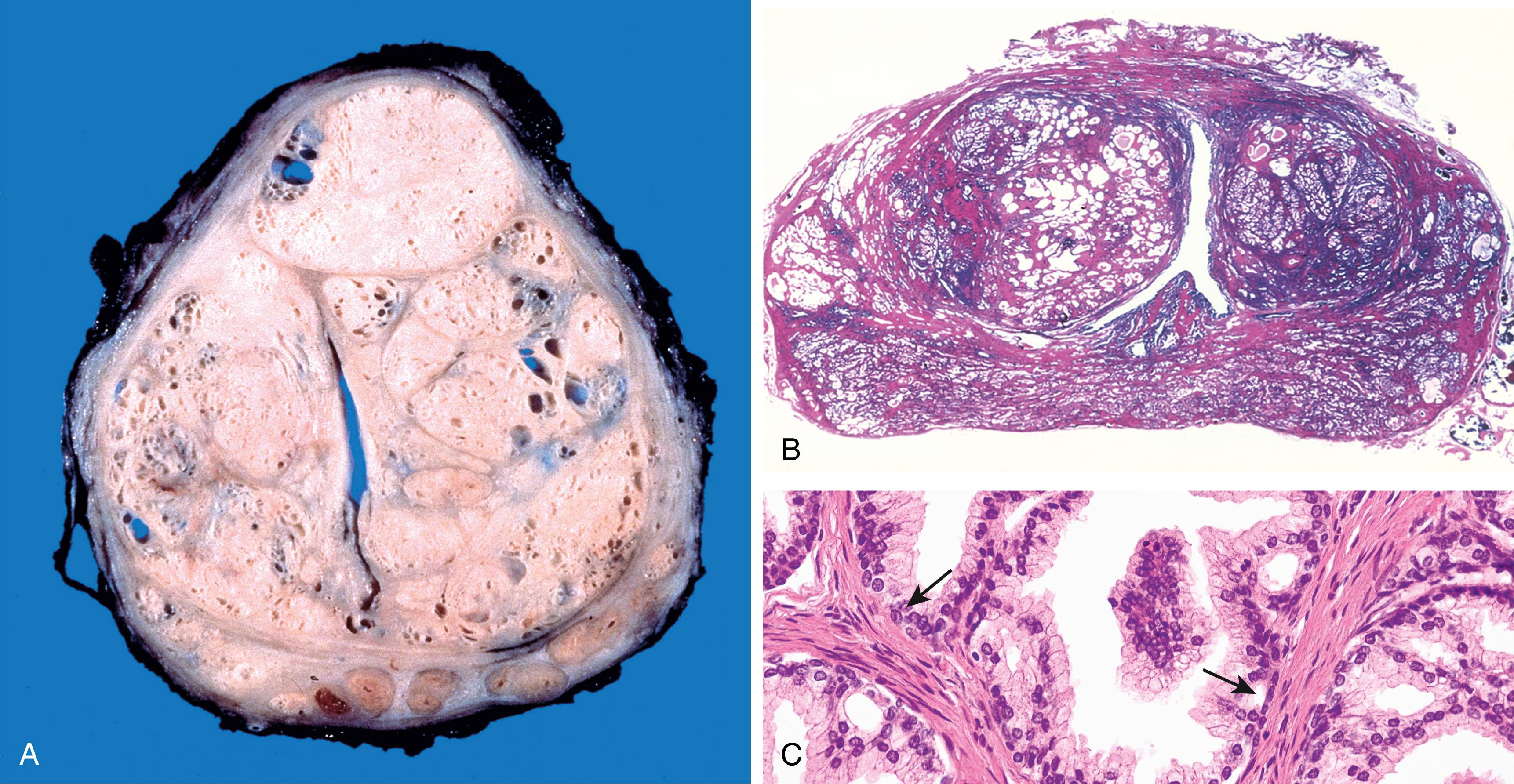
Microscopically, the hyperplastic nodules are composed of variable proportions of proliferating glandular elements and fibromuscular stroma ( Fig. 16.11B ). The hyperplastic glands are lined by tall, columnar epithelial cells and a peripheral layer of flattened basal cells ( Fig. 16.11C ). This is a point of distinction from malignant glands in prostatic carcinoma (discussed next). The glandular lumina often contain laminated proteinaceous secretory material known as corpora amylacea ( eFig. 16.3 ).
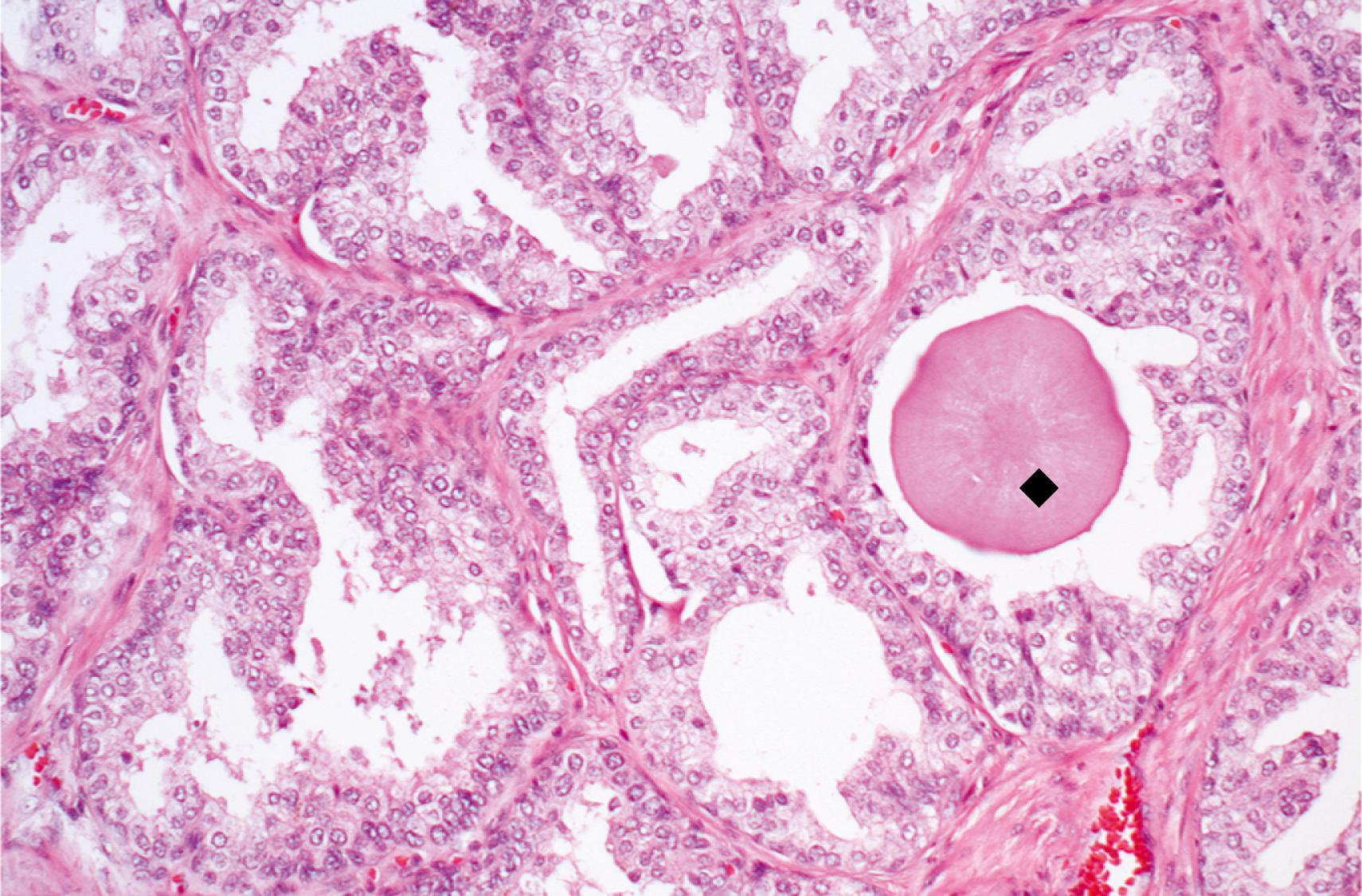
The main symptoms of BPH are due to urinary obstruction caused by prostatic enlargement and stromal smooth muscle–mediated contraction. The increased resistance to urinary outflow leads to bladder hypertrophy and distention, accompanied by incomplete emptying of the bladder and presence of residual urine ( eFig. 16.4 ). The reservoir of residual urine provides a culture medium for bacteria, a common source of infection. Patients experience increased urinary frequency, nocturia, difficulty in starting and stopping the stream of urine, overflow dribbling, and dysuria (painful micturition) and have an increased risk of developing bacterial infections of the bladder and kidney. Complete urinary obstruction can result in painful distention of the bladder and, without appropriate treatment, hydronephrosis ( Chapter 12 ). Symptomatic BPH is usually managed medically with α-adrenergic blockers (which relax prostatic smooth muscle by blocking α 1 -adrenergic receptors) and 5α-reductase inhibitors (which inhibit the formation of DHT from testosterone). Various surgical techniques (e.g., transurethral resection of the prostate, high-intensity focused ultrasound [HIFU], laser therapy, hyperthermia, transurethral electrovaporization, and radiofrequency ablation) are reserved for symptomatic cases that are recalcitrant to medical therapy.
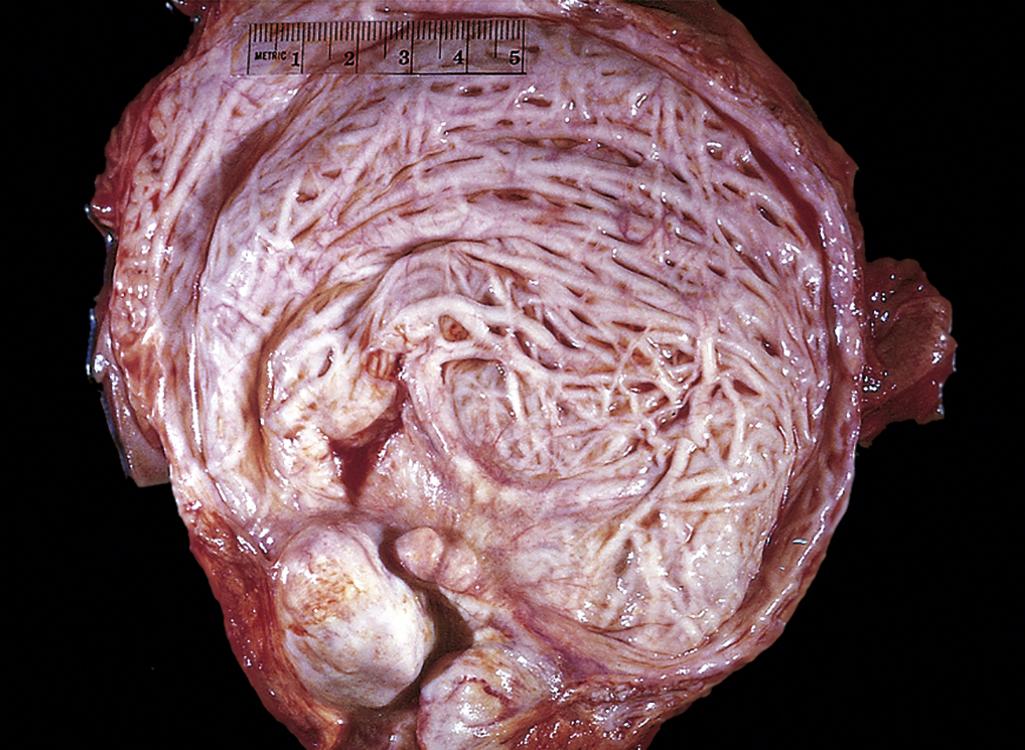
Adenocarcinoma of the prostate is the most common form of cancer in men, estimated to account for 21% of male cancer cases in the United States in 2022. Prostate cancer is the second leading cause of cancer-related death in men, surpassed only by lung cancer. It is largely a disease of aging. Based on autopsy studies, the incidence of prostate cancer increases from 20% in men in their 50s to approximately 70% in men between the ages of 70 and 80 years. There is a wide variation in the natural history of prostate cancer, from aggressive and rapidly fatal to more common indolent disease of little clinical significance. In the United States, African American men die from prostate cancer at a rate more than double that of European American men. The causes of this disparity are not understood though unequal access to screening and treatment make a major contribution.
Become a Clinical Tree membership for Full access and enjoy Unlimited articles
If you are a member. Log in here